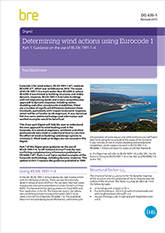
Determining wind actions using Eurocode 1 : Part 1: Guidance on the use of BS EN 1991-1-4 (DG 436-1) DOWNLOAD
THIS PUBLICATION HAS BEEN ARCHIVED.
Whilst this publication can still be purchased some of the information in it has been superseded by more recent research and standards. The BRE Group does not accept any responsibility whatsoever for any loss or damage, including - without limitation - indirect or consequential loss or damage arising from use, or loss of use, of data or profits arising out of, or in connection with, the use of this document.
The Eurocode for wind actions, BS EN 1991-1-4, replaces BS 6399-2, which was withdrawn in 2010. The scope of BS EN 1991-1-4 is much wider than BS 6399-2: where BS 6399-2 was limited to building structures and mildly dynamic response, BS EN 1991-1-4 includes buildings and civil engineering works and a more comprehensive approach to dynamic response, including vortex shedding and other aerodynamic instabilities. There are a number of significant differences between these standards, particularly with respect to dynamic response, which will be unfamiliar to UK engineers. It was therefore felt that some additional background information and worked examples would be beneficial.
This three-part Digest will help the user to understand the new approach to wind loading used in the Eurocode. It is aimed at engineers, architects and other professionals who need to understand how to calculate the effect of wind on buildings and design options to minimise it. Wind loads on bridges are not covered in this Digest.
Part 1 of this Digest gives guidance on the use of BS EN 1991-1-4, its UK National Annex and the non-conflicting complementary information published in PD 6688-1-4. Parts 2 and 3 give worked examples of the Eurocode methodology, including dynamic response, which will be new to users of BS 6399-2. This update to Part 1 replaces the guidance published in 1999.
